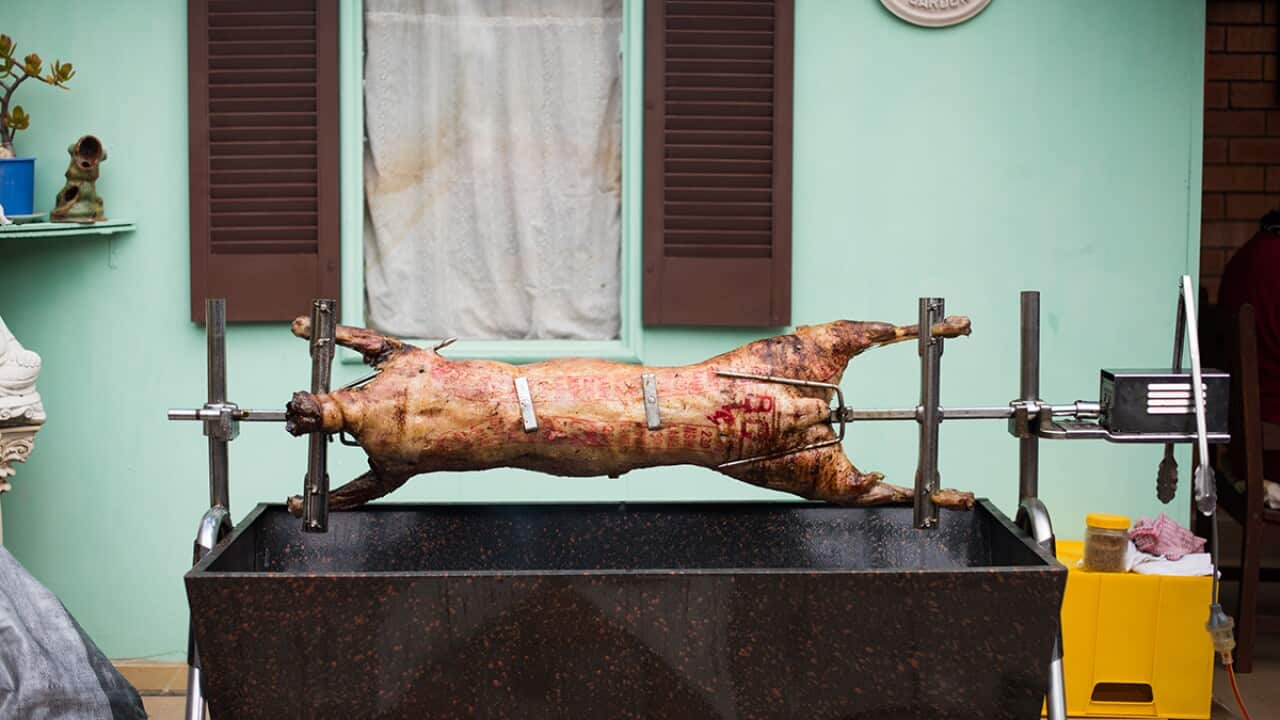serves
30-40
prep
30 minutes
cook
6 hours
difficulty
Mid
serves
30-40
people
preparation
30
minutes
cooking
6
hours
difficulty
Mid
level
Ingredients
- 20 garlic cloves, 10 crushed and 10 thickly sliced
- 125 ml (4 fl oz/½ cup) olive oil
- 1 12–15 kg (26 lb 7 oz–33 lb) lamb – any bigger and they will be fatty and not spring lambs
- handful of fresh rosemary sprigs
- 4 lemons, halved
George’s spice rub
- 1 cup dried oregano
- ½ cup paprika
- 2 tbsp dried rosemary
- 1 tbsp onion powder
- 1 tbsp ground fenugreek
- 1 tbsp salt
For basting
- 500 ml (17 fl oz/2 cups) lemon juice
- 500 ml (17 fl oz/2 cups) olive oil
- 1 tbsp dried oregano
- 2 tbsp smoky paprika
- 1 tbsp black pepper, ground
- 5 garlic cloves, crushed
- 250 ml (8½ fl oz/1 cup) white wine
- 1 beef stock cube (optional)
Instructions
Line the tray of the spit with foil and start to build your fire with a combination of hardwood charcoal (David likes ironbark) and kindling, leaving the middle part clear (this is so that the belly of the lamb doesn’t burn when you start cooking). Set the coals alight. Add a little more kindling over the charcoal once it’s lit.
It should burn until the wood is radiating and glowing red-hot with minimal flames. Add additional wood to continue the heat building steadily and consistently.
In a mixing bowl, combine 10 crushed garlic cloves with the olive oil and mix thoroughly into a paste. Set aside.
Combine the ingredients for George’s spice rub in a mixing bowl, and set aside.
Combine the ingredients for basting in another mixing bowl and set aside.
Skewer the lamb through the centre onto the spit and anchor firmly in place with spit prong forks.
Rub the garlic and olive oil paste around the cavity of the lamb, then sprinkle with George's special mix. Put a handful of rosemary sprigs and cut lemons inside.
Sew the carcass together using a butcher’s needle and twine. Sew one way, then continue to sew back in the other direction, forming a crisscross-style stitch.
Create incisions in the thickest parts of the shoulders and legs – around four to six each quarter. Sprinkle the incisions with George’s special rub and then insert a piece of cut garlic clove.
Rub a little of the spice rub all over the lamb (not a lot as it will discolour the lamb and make it go black).
Sprinkle with salt and rub well into the skin.
Place the lamb on the spit and start cooking over high heat – it’s around 400–450°C (750–840°F) at this stage. You will slowly reduce the temperature over the next 6 hours. Start to baste after 30 minutes, then again every 30 minutes or so until the lamb is cooked.
Gradually add coals to keep the heat constant. Lower the lamb in the beginning so it absorbs as much of the heat early and then raise it so it cooks slowly. The longer and more evenly you cook it at an even heat, the more the lamb will become tender and fall apart. And with continuous basting it will not dry out.
Cook for at least 5–6 hours. When the skin cracks and becomes tight and the fat has rendered off, it's ready. Another telltale sign is when you insert a skewer and clear bubbling liquid emerges.
David’s father, George, carves straight off the spit, with a metal tray underneath to catch all the juices.
Recipe from Food Safari Fire by Maeve O'Meara (Hardie Grant, hbk, $55). Photography by Kaily Koutsogiannis.
starts Thursday 7 January 2016 at 8pm on SBS. Visit the for recipes, videos and more.
Cook's Notes
Oven temperatures are for conventional; if using fan-forced (convection), reduce the temperature by 20˚C. | We use Australian tablespoons and cups: 1 teaspoon equals 5 ml; 1 tablespoon equals 20 ml; 1 cup equals 250 ml. | All herbs are fresh (unless specified) and cups are lightly packed. | All vegetables are medium size and peeled, unless specified. | All eggs are 55-60 g, unless specified.









